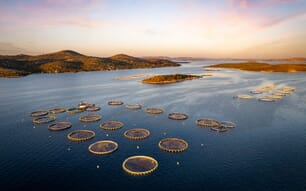Compared to 2011, the production value and weight increased by 3.4 per cent and 3.8 per cent, respectively.
Aquaculture data collected under the DCF showed that the sales volume and value reached 1.388 million tonnes and €4.368 billion, in 2012. This corresponds to an increase of three per cent in sales volume and 10 per cent in sales value.
EU aquaculture production is mainly concentrated in four countries: Spain, United Kingdom, France and Greece, making up 71 per cent in volume and 70 per cent in value of EU28 totals.
The 20 countries covered under the DCF reported a number of more than 12 thousand aquaculture enterprises. It is estimated that the total number of enterprises in EU28 is between 14 and 15 thousand.
Around 90 per cent of the enterprises in the aquaculture sector are micro-enterprises, employing less than 10 employees. The reported number of employees under the DCF reached 69,000 thousand in 2012.
The total EU28 employment is estimated to be around 80,000 thousand people. The number of FTE reported decreased by two per cent , which might indicate a tendency towards higher specialisation and less part-time employment in the sector.
However, the use of part time labour still significantly contributes to the workforce in the European aquaculture sector. Female employment made up 24 per cent of EU aquaculture employment and 17 per cent of total FTE.
The average yearly wage was €22,100, corresponding to a nine per cent increase compared to 2011.
Profitability for the EU aquaculture sector was positive in 2012 and the Gross Value Added of the sector increased by four per cent. However, the EBIT decreased by 26 per cent and ROI decreased from nine per cent to seven per cent.
Furthermore, the labour productivity decreased by four per cent from 2011 to 2012.
The aquaculture sector in EU28 can be divided into three main sectors: Marine, Shellfish and Freshwater production. The most profitable of these three sectors are the Marine sector which generated €179.3 million in EBIT, followed by the shellfish sector with €130.1 million and the freshwater sector with €32.6 million.
The main species produced in EU28 in terms of value are Atlantic salmon, oysters, seabream, seabass and trout, whereas the Mediterranean mussels dominate in weight.
In the marine sector, the United Kingdom is the main producer of salmon covering 88 per cent of the value, while Greece is the main producer of seabream and seabass covering 53 per cent of the value.
In the shellfish sector France and Spain are the most important countries in terms of production volume and value, employment and numbers of enterprises. France is the main producer of oysters covering 89 per cent of the total EU28 production, whereas Spain is the main producer of Mediterranean mussels covering 43 per cent of the volume.
The main producer of clam is Italy, however Portugal has the largest numbers of enterprises and employment in this sector.
The main species produced in freshwater in terms of volume 48 per cent and value 43 per cent is trout. The most important producers in terms of value are Italy (28 per cent), France (18 per cent) and Denmark (14 per cent).
Carp is another important species mostly produced in Eastern Europe, where the main producer is Poland covering 39 per cent in terms of total value.
The technical innovations introduced to manage or overcome the technical externalities in the European countries are only expected to have a minor positive effect on future growth, in the short run (2013- 2014).
A few countries have positive expectation do to the changes in legislation and the issuing of new licenses, which is expected to affect production volume.
In the North European EU countries, the focus on environmental regulation for the inland farms has advanced the introduction of more sophisticated RAS technology. However, to insure future growth the development of the RAS technology most continue.
Furthermore, the prices of building the new RAS systems must be lowered to become an economically attractive investment.
A special issue concerning the Mediterranean EU countries is the lack of available credit due to financial crisis. This seems to be an important issue shared by these countries and is considered an important hindrance to growth.
A majority of the experts point out that the administrative issues are far more important to solve than the technical ones. The EWG 14-10 experts identified environmental regulations, difficulties in the licenses process due to multilevel governance and competition for space both on land and in the costal zones as the most important areas to be addressed to increase growth in the EU aquaculture sector.
It still seems that providing better framework condition for the aquaculture industry is by far the most important issue to solve to lay the foundation for future growth in the European aquaculture sector.
You might also be interested in:
- New Research Helping EU Aquaculture Become More Competitive
- EU Outlines Measures to Help Agriculture, Fisheries Affected by Russian Import Ban
- Will the Multiannual Strategic Plan for Spanish Aquaculture Promote Growth in the Sector?
Further Reading
You can view the full Economic Performance of the EU
Aquaculture Sector report by clicking here.


